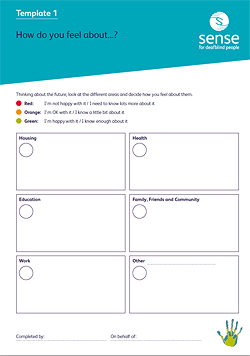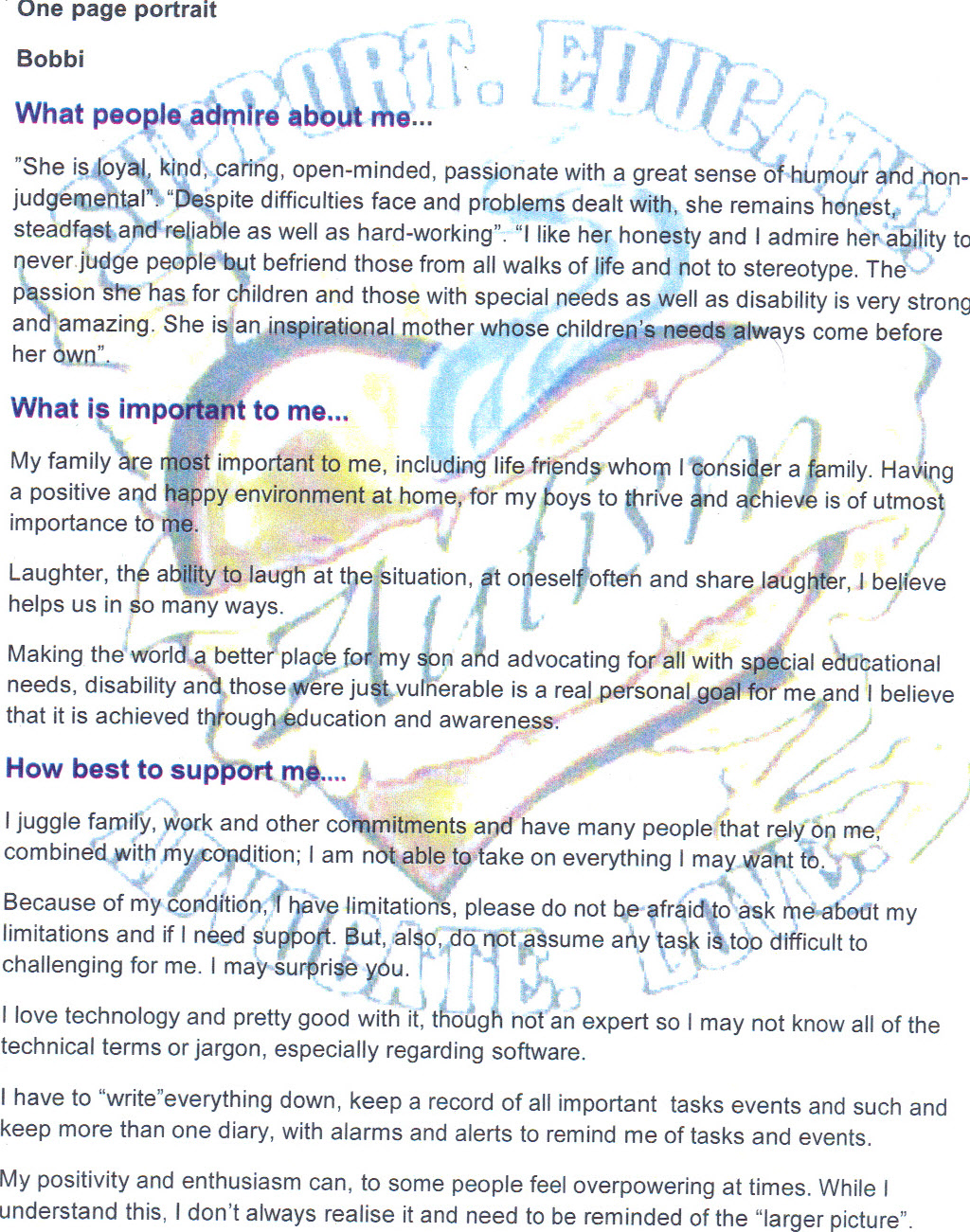Person-Centred Thinking
This refers to the foundation skills and tools that underlie all the discovery of who a person is and how they want to be supported. It is an ongoing process intended to change the way we plan, design and deliver care & support, ultimately aimed at helping people get better lives by listening to them well. These tools are vital to support autistic children and young people.
Person Centred Thinking links with Person Centred Reviews, support planning processes being piloted for Personal Budgets / Education, Health & Care Plans, Government plans to involve parents/carers more in planning and commissioning of services, Government plans to give individuals with SEN/disabilities more control and choice in their own lives. the tools include, The One Page Profile, Working and Not Working, and The Communication Chart.
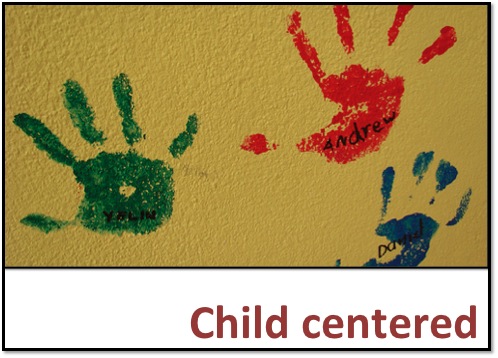
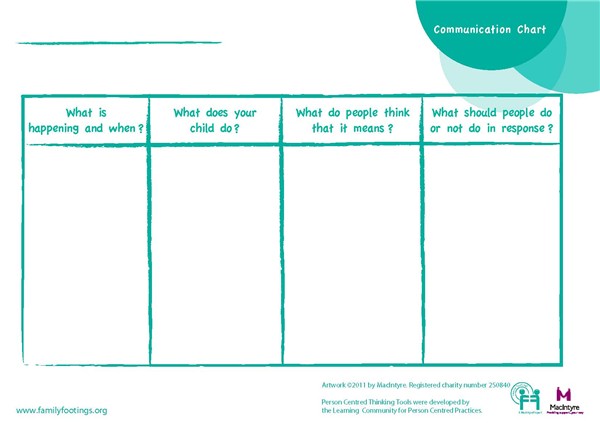
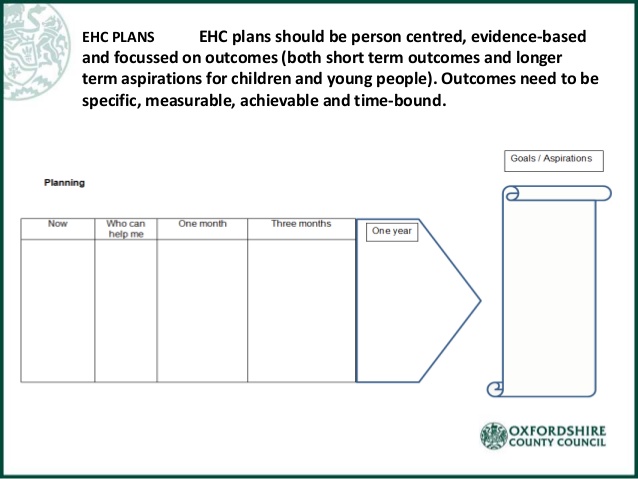
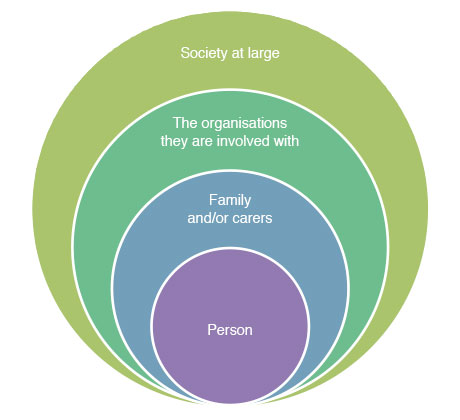

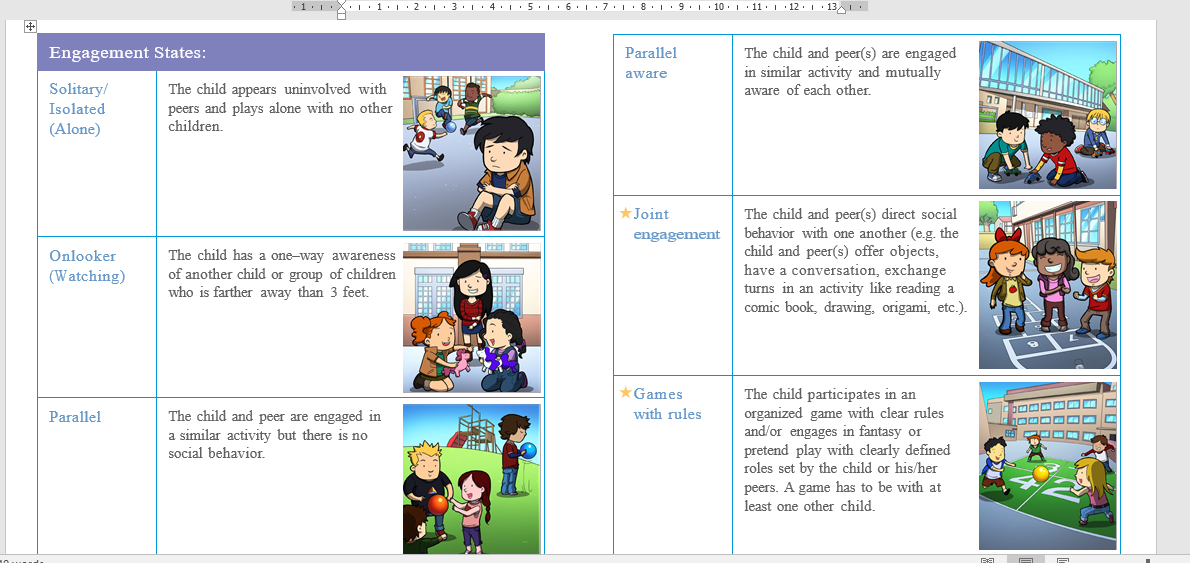
“Person Centred Thinking and tools benefit:
Individuals:
•Offers more consistency in the way the person is understood and supported
•Helps the person to adapt to new people and new situations
•Ensures needs are met, and communication is understood from the outset in a new situation.
Professionals:
•Can give a head start in building a good relationship with the young person
•Provides a good focus for a first meeting with a family
•Can offer more consistency in the way the person is understood and supported,
pre-empting potential difficulties
Parents:
•Can help to present information about the young person in an organised way
•Is flexible enough to be adapted for different occasions
•Allows parents to share valuable information to keep their child safe, but in a format that is a celebration of who the child is, rather than a list of needs.
When can you use it?
•When the young person is about to start in a new place or with a new person
-When you feel that the people who already support your child are “stuck in a rut”.
•To introduce someone new in a positive and constructive way.
This is just one of the areas I am trained in and have trained others in. It is a vital part of the School SEN responsibilities.”
The One Page Profile/Portrait/Passport
The One Page profile- Single Page Portrait is a tool and it is only as good as it is applied. By that, we mean all communication is of the utmost importance (e.g. all must be involved- parents, teachers, TA/LSA, Heads of Year, and all those involved with the child/young person. )
It is living in that it is continually updated as necessary.
Teachers and all staff involved getting a snapshot of the child.
it is a confidence booster for the child and parents, as it empowers them. Other professionals involved with the family can also benefit from the document as the parents can use their copy as they see fit.
Ultimately, it helps avoid misunderstandings, miss communications, miss interpretations between all those working with the child/young person and the parents. It also helps the child/young person avoid the frustrations that can easily come from being misinterpreted and misunderstood.
this is just one of the areas I am trained in and have trained others in. It is a vital part of the School SEN responsibilities.
Please contact me for more information and fees.
Working and Not Working
This can be a very useful tool to use:
To maintain a balanced view of a situation
In reviews or other formal meetings
In conflict situations, or any time you feel like your perspective or your child’s perspective is not being heard
At home to “check in” regularly with members of your family .
It is a vital part of the School SEN responsibilities.
Please contact me for more information
The Communication Chart
This is an important tool as part of the person-centred approach. It looks at the behaviour and what is behind it. All "behaviour" is communication and sometimes we have to be detectives to work out what the child or young person is trying to communicate in that "behaviour". No behaviour is "challenging" in that the child or young person displaying it is not "challenged" by it. It is usually those around the child or young person, those who care for and support them that are challenged by them. The tools look at understanding them, what is being communicated and how to educate others in regards to them.
The questions include:
What is happening?
These are all of the external things that are happening. The time of day, who is around, What has just happened.
What does the child or young person do?
This is what the young person actually does.
The things that can be felt, heard or seen by other people. Record this as specifically as possible so that other people know what the young person does.
What do people think that it means?
This is what people think the young person is trying to say through their actions. It is OK to use your best guess here and check it out.
What should people do or not do in response?
This identifies good support for the young person at that time. Be Specific and clear in what people should or should not do. Also include the most obvious things.
“REMEMBER to ask yourself...
What is happening?
What does your son or daughter do?
What do people think that it means?
What should people do or not do in response
What is being communicated?
Who actually is being challenged?”
This is also a vital part of the School SEN responsibilities.
Understanding and Working with Children and Young People on the Autism spectrum
What autism is and what does it mean for those who are autistic?
Current statistics say that 1 in 64 to 1 in a 100 is born autistic, chances are you are already working with or know someone who is autistic. The internet is full of "stories" myths and the newest "therapies" in regards to autism but there is little out there about the facts. How it is actually diagnosed, what it feels like to a child to be autistic in society today. It can be hard to figure out what is fact and what is fiction.
By first understanding what autism actually is, How it is diagnosed and what the criteria is for diagnosis can someone then start to navigate how to support and then work with the autistic child/young person or adult.
The training sessions I can provide can range from three hours to a six week ( meeting once a day) sessions and anywhere in between to meet the need required. They are mainly practical interactive sessions .
With the recent government's recent SEN reforms and it's disabled child policy
Educational settings, schools, nurseries, etc. have a responsibility to all SEN children and young adults. With the recent introduction of the EHCP, understanding the needs of autistic children and young people is Good Practice for schools and beneficial to parents.
Please contact for more information.
Excerpt from training session:
““Today is about autism awareness, what Autism is and means for our students who are Autistic. But it isn’t going to be just full of facts and information, and there is that part but it will also be more practical and my hope is that any questions you have now or may have during the session today can be answered. but that depends on you and I urge you to ASK! I also hope that many of the information and ideas are given today can really be applied to all children at our schools and benefit everyone.””
"Remaking Recess"
A session for Lunchtime Supervisors introducing them to "structured" facilitated play
The purpose of this intervention is to improve the social inclusion of Primary aged ( Autistic) children through “facilitated interactions” with their peers, that respect the Autistic experience instead of forcing compliance. The facilitation is for the neurotypical peer, not the autistic child.
I was lucky enough to gain full authorisation as well as support from Mark Kretzmann, Jill Locke, and the Kasari Research Group UCLA for the Autism Intervention Research Network on Behavioral Health (AIR–B), who are the creators of "Remaking Recess". (For more information go to www.asdweb.org or email mistermark@ucla.edu.)
We will go over specific strategies for Lunchtime Supervisors to use on the playground and in the cafeteria. Some will seem difficult, some will seem easy, some will even be strategies that you already use. These tools and strategies are not exclusive to Autistic students but can and does benefit all students. This is delivered in a way that honours and respects the Autistic child and does not involve compliance “training”.

